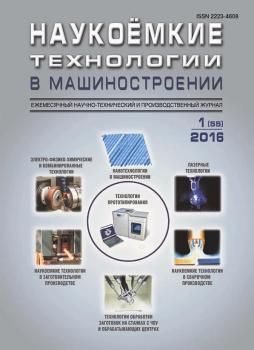Tula, Tula, Russian Federation
Moskva, Moscow, Russian Federation
UDK 621.98 Обработка листового материала. Гибка. Глубокая вытяжка, выдавливание на давильных станках и т.д. Способы (технология), машины и инструменты
UDK 539.375 Предельная деформация. Деформация при разрушении
High-strength materials are pressure-treated under isothermal conditions with heating using a hydraulic forging equipment. At the same time, along with strainer- hardening, the workpiece material exhibits viscous properties, i.e. it is viscoplastic. This factor must be taken into account when developing pressing technology, since the power modes of stamping and the maximum possibilities of shaping depend significantly on the speed of the operation. A yield with heating of a ring blank under viscoplastic conditions is viewed. The relations for calculating the force and deformation modes of a ring blank yield under the axial symmetry scheme are proposed. The energy method of balancing the capacities of internal and external forces was used to calculate the power regime. Coulomb's law of friction is adopted on both: tool contact surfaces and the ring blank. The internal force capacities were calculated in the deformation block and on the fracture surfaces of the displacement velocities in accordance with the selected kinematically possible velocity field, including the friction surfaces. The optimization of the velocity field was carried out according to the principle of minimum operating pressure. The assessment of the damage to the material of the blank is carried out according to the energy and deformation criteria of destruction. The calculated results of the yield force and material damage for high-strength aluminum and titanium alloys are presented. It is shown that under isothermal yield of a ring blank, the force decreases at low operating speeds. The damage rate of a number of materials, the behavior of which is described by the energy theory of destruction, decreases with a decrease in the speed of the operation. For materials subject to the deformation theory of fracture, the rate of deformation has no effect on damage, but is determined only by the degree of deformation.
viscoplasticity, power, speed, pressure, material damage
Введение
Процессы горячей осадки заготовок применяют в кузнечно-штамповочном производстве [1]. Высокопрочные материалы обрабатывают давлением в изотермических условиях с нагревом в оснастке на гидропрессовом оборудовании. При этом наряду с деформационным упрочнением материал заготовки проявляет вязкие свойства, т. е. является вязкопластичным. При заданной степени формообразования происходит релаксация напряжений, которая тем больше, чем меньше скорость деформирования [2 – 5]. Этот фактор необходимо учитывать при разработке технологии обработки давлением. Рассмотрим осадку с нагревом кольцевой заготовки в условиях вязкопластичности. Схему деформаций примем осесимметричной. Оценку силового режима операции произведем энергетическим методом [6, 7], используя кинематику процесса осадки. Схема осадки приведена на рис. 1.
Кинематика, мощность, давление
Для расчета давления осадки установим кинематику процесса. Воспользуемся разрывным полем скоростей перемещений (рис. 1, а), которое состоит из блока деформаций 1 и жестких блоков 0, 2, разделенных линиями разрыва 02, 12 скоростей. Линии разрыва являются образующими поверхностей вращения относительно оси координат x. Деформации происходят в блоке и на поверхностях разрыва скоростей. Скорость в блоке 1 зададим функцией:
 – ордината вектора скорости;
– ордината вектора скорости;  – уравнение линии «01»;
– уравнение линии «01»;  – внутренний и внешний радиусы кольцевой заготовки;
– внутренний и внешний радиусы кольцевой заготовки;  – конечная высота заготовки;
– конечная высота заготовки;  – углы поля скоростей. Функция (1) соответствует граничным условиям на входе в блок деформаций и на выходе из него, т. е.
– углы поля скоростей. Функция (1) соответствует граничным условиям на входе в блок деформаций и на выходе из него, т. е.
Уменьшение давления с понижением скорости операции происходит также в процессах объемной [3, 4, 8] и листовой [5, 9 - 11] штамповки с нагревом на гидропрессовом оборудовании. Повреждаемость сплава АМг6 зависит от скорости осадки и в пределах указанной скорости составила  .
.
Повреждаемость сплава ВТ6С при заданной температуре  зависит только от степени осадки.
зависит только от степени осадки.
Выводы
1. Горячая осадка на гидропрессовом оборудовании при малых скоростях деформирования происходит в условиях вязкопластичности. Материал заготовки релаксирует, что приводит к снижению давления формоизменения. Давление снижается тем больше, чем меньше скорость операции.
2. Повреждаемость деформируемого материала может зависеть от скорости операции или только от степени формоизменения.
1. Forging and stamping: a reference book: in 4 volumes / ed. Council: E.I. Semenov (prev.) [et al]. 2nd ed., revised. Moscow: Mashinostroenie, 2010, vol. 2: Hot volumetric stamping / A.P. Atroshenko [et al.]; edited by E.I. Semenov, 2010, 720 p.
2. Malinin N.N. Creep in metalworking. Moscow: Mashinostroenie, 1986, 216 p.
3. Chudin V.N., Platonov V.I., Romanov P.V. Variation assessment of yield mode at pressure welding // Science-intensive technologies in mechanical engineering, 2021, no.3(117), pp. 16–18. doi:https://doi.org/10.30987/2223-4608-2021-3-16-18
4. Chernyaev A.V., Chudin V.N. Isothermal flash-free stamping with non-stationary viscoplastic deformation // Forging and stamping production. Pressure treatment of materials, 2019, no. 2, pp. 16-21.
5. Isothermal deformation of high-strength anisotropic metals / S.P. Yakovlev, V.N. Chudin et al. Moscow: Mashinostroenie 1; TulSU Publishing House, 2004. 427 p.
6. Theory of metal processing by pressure / V.A. Golenkov [et al.]; edited by V.A. Golenkov, S.P. Yakovlev. 3rd ed. Moscow: Mashinostroenie, 2013, 441 p.
7. Kolmogorov V.L. The Mechanics of Metal Processing under Pressure: Textbook,Yekaterinburg: Ural State Technical University (UGTU-UPI), 2001, 836 p.
8. Pasinkov A.A. Upsetting of a flange on pipeline parts during viscoplastic unsteady deformation // Forging and stamping production. Pressure treatment of materials, 2021, no. 3, pp. 10-15.
9. Platonov V.I., Pasinkov A.A., Chudin V.N. Technological modes of anisotropic relaxing material drawing// Science-intensive technologies in mechanical engineering, 2022, no. 2 (128), pp. 22-25. doi:https://doi.org/10.30987/2223-4608-2022-2-22-25
10. Pasinkov A.A., Yakovlev B.S. Hot crimping of large-sized pipe blanks // Science-intensive technologies in mechanical engineering, 2021, no. 12 (126). pp. 7-11. doi:https://doi.org/10.30987/2223-4608-2021-12-7-11
11. Larin S.N., Bessmertnaya Yu.V. Hot forming of box-shaped material blanks under isothermal conditions // Science-intensive technologies in mechanical engineering, 2024, no. 6 (156), pp. 21-28. doi:https://doi.org/10.30987/2223-4608-2024-21-28
















